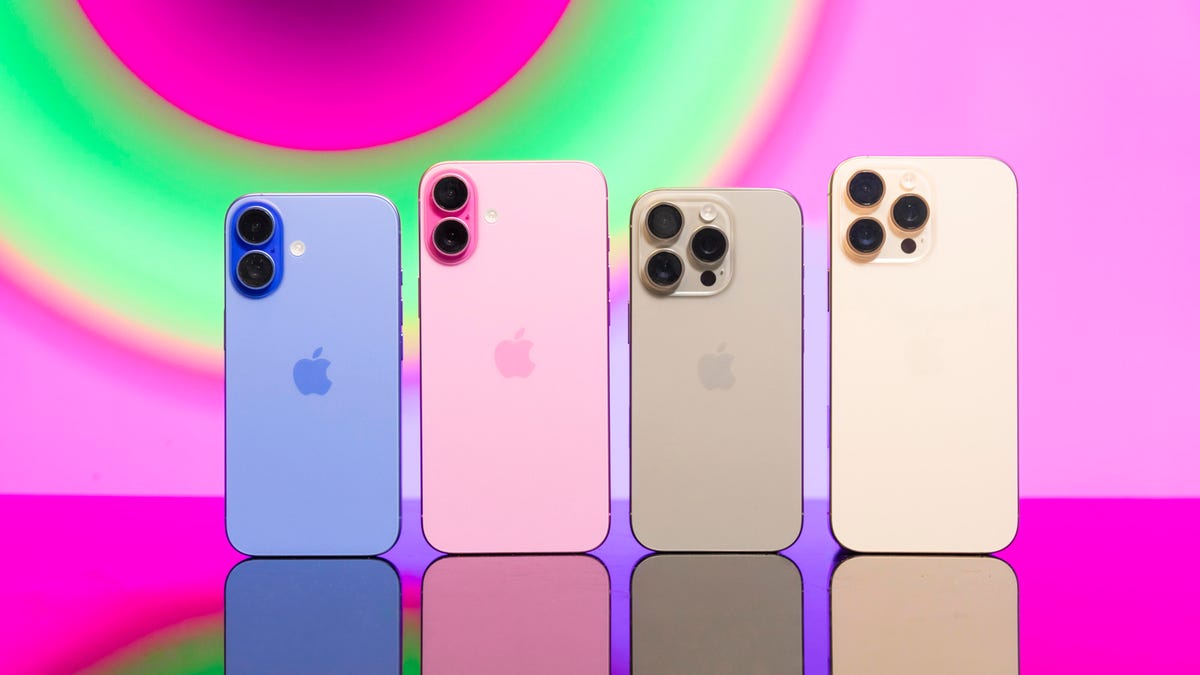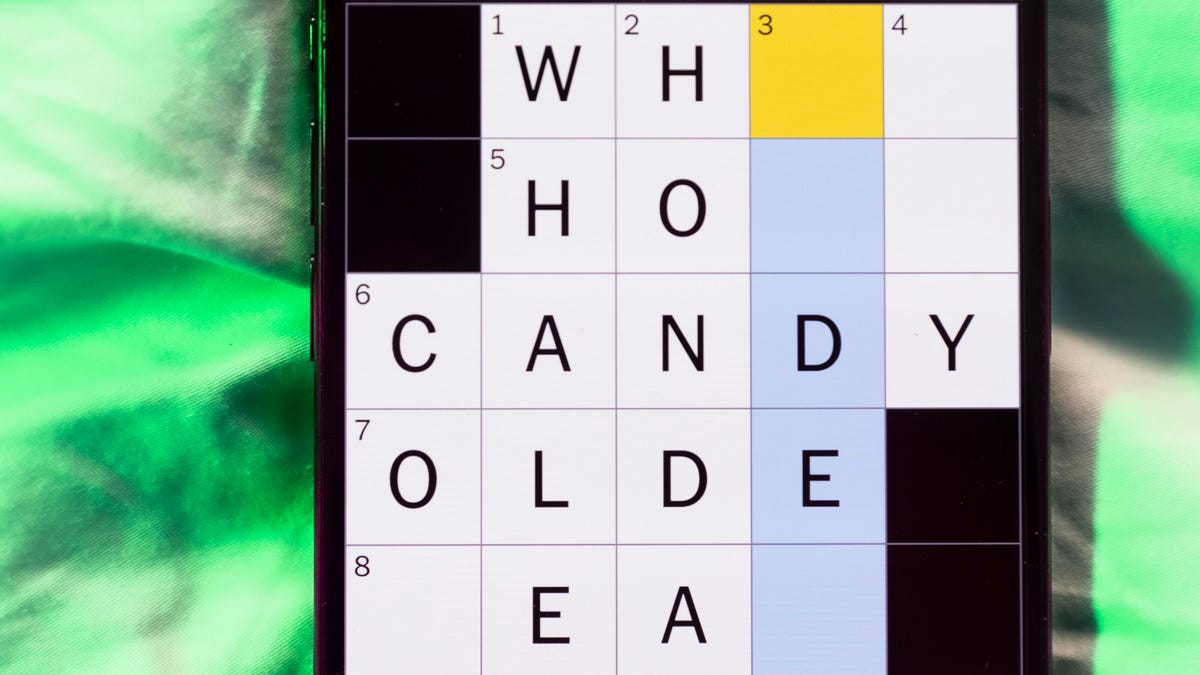Technologies
iPhone 17 vs. 17 Air, 17 Pro, 17 Pro Max: All the Rumored Specs Compared
Here’s how Apple’s iPhone 17 lineup will differ — at least according to rumors we’ve heard.

Normally, we wait until phones are released to compare them, but Apple’s next iPhone models are so eagerly awaited that we’ll make an exception. We’re basing our comparisons on the most credible rumors of what’s coming in the iPhone 17 series, including a potential superthin iPhone 17 Air, to give readers an early sense of how the new series of phones may look.
Last year’s iPhone 16 series added a handful of upgrades on its predecessors, most notably the new Camera Control key. While the basic iPhone 16 and Plus models got a new ultrawide camera and bigger battery, as is typical with Apple’s phones, the iPhone 16 Pro and Pro Max got the lion’s share of the improvements with upgraded rear cameras, pro video recording modes and thinner bezels.
Last year’s iPhone upgrades are a template for what we expect in the iPhone 17 — here’s how we anticipate those comparisons to shake out.
iPhone 17 price and release date
Apple traditionally holds its iPhone announcements the first Tuesday in September after Labor Day. This year, that would be the first Tuesday of the month (Sept. 2), so we’d expect the reveal event on the next day, Sept. 3, or the following Tuesday, Sept. 9. A number of rumors point to Sept. 9 being the day Apple holds its fall event.
The iPhone always goes on sale the Friday of the week after it’s announced. Depending on which day it’s announced, that could mean the iPhone 17 release date would be either Friday, Sept. 12 or 19.
The iPhone 17 prices are up in the air, mainly due to tariffs. Increased costs of imports mean Apple could raise iPhone price tags, with Jefferies analyst Edison Lee predicting a $50 price hike across the lineup. If that’s the case, then anticipated US starting prices could be as follows:
- iPhone 17: $829
- iPhone 17 Air: $979
- iPhone 17 Pro: $1,049
- iPhone 17 Pro Max: $1,249
Design and display
The biggest change we expect in the iPhone 17’s design is in a single model potentially added to the lineup: the iPhone 17 Air. Following plenty of rumors, the Air would be a thinner model of the iPhone line akin to the Samsung Galaxy S25 Edge, which would focus on a thinner, lighter body that might have reduced battery life as a consequence. CNET Senior Reporter Abrar Al-Heeti found that with the S25 Edge. The Air could take the place of the larger Plus model in the iPhone 17 lineup, though whether that means the thinner phone is also bigger than the standard model is far from certain.
We’ve also heard rumors that the iPhone 17 line could swap from the square camera block it’s used for years to more of a pill-shaped camera bar that runs across the width of the phone’s body. Leaker Majin Bu posted a leaked image and CAD renders on X that show a differently shaped camera setup for each phone. And case-maker Dbrand is preselling an iPhone 17 Pro Tank case that shows off the wider camera bump as well.
iPhone 17 Lineup CAD pic.twitter.com/xednTkpJnq
— Majin Bu (@MajinBuOfficial) February 23, 2025
A Bloomberg report in April affirmed that other than the camera block, the iPhone 17 lineup will look much like last year’s phones, at least as far as rumors go, with the standard iPhone 17, Pro and Pro Max models largely unchanged from their iPhone 16 predecessors.
Assuming Apple isn’t changing the sizes of the smartphones, expect the iPhone 17 to have a 6.1-inch display, the iPhone 17 Pro to get a 6.3-inch screen and the iPhone 17 Pro Max a 6.9-inch display. The iPhone 17 Air’s size is uncertain, but Apple does have a tendency to retain phone sizes for years (just look at the iPhone SE line using the same display dimensions as the iPhone 6), so if the new thin phone has the same dimensions as the iPhone 16 Plus, it could have a 6.7-inch display.
Another display rumor suggests that Apple will close a feature gap between the baseline and pro models by making all phones have a maximum 120Hz refresh rate (prior lineups have kept the cheaper phones at 60Hz).
Cameras
While the camera bump may be changing in design, it’s not clear how much the actual cameras themselves will change from last year’s iPhone 16 lineup.
We expect the usual feature gap to split the iPhone 17 generation, with the standard iPhone 17 having two cameras (48-megapixel main and 12-megapixel ultrawide) while the Pro and Pro Max models bump the ultrawide to 48 megapixels and also include a third telephoto camera (presumably the 12-megapixel with 5x optical zoom inherited from last year’s iPhones). One of the wildest rumors is that the 17 Pro and Pro Max will have 8x telephoto cameras. The report comes from MacRumors and mentions the lens having moving elements for continuous optical zoom at various focal lengths (think Sony Xperia 1 V).
Rumors suggest the fourth model — possibly the iPhone 17 Air — will only have one camera, which would likely be a 48-megapixel main shooter similar to the iPhone 16E. That would set it apart from last year’s iPhone 16 Plus, which had the same two cameras as the standard iPhone 16.
The only other significant camera rumor suggests that the front-facing shooters on all the phones will be upgrading to 24-megapixel cameras, up from 12 megapixels on last year’s phones.
Specs and software
As is typical with the feature gap between standard and pro models, rumors suggest the iPhone 17 Pro and Pro Max (as well as the Air) will get the newest A19 chip, while the regular iPhone 17 will get the same A18 chip that powered last year’s iPhone 16.
It’s unclear if the new phones will get another tech advancement — Apple’s C1 chip, the internally developed 5G modem that debuted in the iPhone 16E released earlier this year. Presumably, the company will want to bring it to the new iPhone 17 lineup, but we haven’t heard rumors suggesting so.
While Apple never explicitly says how much RAM its iPhones pack, most phones require 8GB of RAM to use AI features — and given Apple Intelligence debuted on the iPhone 16 lineup, it’s heavily suspected that those devices were given 8GB of RAM. Presumably, the iPhone 17 series will have the same amount.
There’s also no reason to believe Apple will switch up its storage options. The standard iPhone 17 will likely be offered in 128GB, 256GB and 512GB tiers, while the iPhone 17 Pro should have those and a 1TB version. The iPhone 17 Pro Max will likely only have 256GB, 512GB and 1TB options.
The batteries of the iPhone 17 and iPhone 17 Pro aren’t expected to change, though a leak suggests the iPhone 17 Pro Max could expand its capacity to 5,000 mAh, up from the 4,685 mAh on the iPhone 16 Pro Max. The big question will be the size of the iPhone 17 Air’s battery, which will almost surely be smaller due to the thinner body; by comparison, the Samsung Galaxy S25 Edge only has a 3,900 mAh capacity.
All iPhones will almost surely launch with iOS 26, the next version of Apple’s iPhone software that was renamed to align with the year following its release.
Technologies
Today’s NYT Connections Hints, Answers and Help for Dec. 24, #927
Here are some hints and the answers for the NYT Connections puzzle for Dec. 24 #927

Looking for the most recent Connections answers? Click here for today’s Connections hints, as well as our daily answers and hints for The New York Times Mini Crossword, Wordle, Connections: Sports Edition and Strands puzzles.
Today’s NYT Connections puzzle is kind of tough. Ooh, that purple category! Once again, you’ll need to look inside words for hidden words. Read on for clues and today’s Connections answers.
The Times has a Connections Bot, like the one for Wordle. Go there after you play to receive a numeric score and to have the program analyze your answers. Players who are registered with the Times Games section can now nerd out by following their progress, including the number of puzzles completed, win rate, number of times they nabbed a perfect score and their win streak.
Read more: Hints, Tips and Strategies to Help You Win at NYT Connections Every Time
Hints for today’s Connections groups
Here are four hints for the groupings in today’s Connections puzzle, ranked from the easiest yellow group to the tough (and sometimes bizarre) purple group.
Yellow group hint: Cash out.
Green group hint: Chomp
Blue group hint: Walleye and salmon.
Purple group hint: Make a musical sound, with a twist.
Answers for today’s Connections groups
Yellow group: Slang for money.
Green group: Masticate.
Blue group: Fish.
Purple group: Ways to vocalize musically plus a letter.
Read more: Wordle Cheat Sheet: Here Are the Most Popular Letters Used in English Words
What are today’s Connections answers?
The yellow words in today’s Connections
The theme is slang for money. The four answers are bacon, bread, cheese and paper.
The green words in today’s Connections
The theme is masticate. The four answers are bite, champ, chew and munch.
The blue words in today’s Connections
The theme is fish. The four answers are char, pollock, sole and tang.
The purple words in today’s Connections
The theme is ways to vocalize musically plus a letter. The four answers are hump (hum), rapt (rap), singe (sing) and whistler (whistle).
Don’t miss any of our unbiased tech content and lab-based reviews. Add CNET as a preferred Google source.
Toughest Connections puzzles
We’ve made a note of some of the toughest Connections puzzles so far. Maybe they’ll help you see patterns in future puzzles.
#5: Included «things you can set,» such as mood, record, table and volleyball.
#4: Included «one in a dozen,» such as egg, juror, month and rose.
#3: Included «streets on screen,» such as Elm, Fear, Jump and Sesame.
#2: Included «power ___» such as nap, plant, Ranger and trip.
#1: Included «things that can run,» such as candidate, faucet, mascara and nose.
Technologies
Today’s NYT Mini Crossword Answers for Wednesday, Dec. 24
Here are the answers for The New York Times Mini Crossword for Dec. 24.

Looking for the most recent Mini Crossword answer? Click here for today’s Mini Crossword hints, as well as our daily answers and hints for The New York Times Wordle, Strands, Connections and Connections: Sports Edition puzzles.
Need some help with today’s Mini Crossword? I’m Irish-American, but yet 6-Down, which involves Ireland, stumped me at first. Read on for all the answers.. And if you could use some hints and guidance for daily solving, check out our Mini Crossword tips.
If you’re looking for today’s Wordle, Connections, Connections: Sports Edition and Strands answers, you can visit CNET’s NYT puzzle hints page.
Read more: Tips and Tricks for Solving The New York Times Mini Crossword
Let’s get to those Mini Crossword clues and answers.
Mini across clues and answers
1A clue: Wordle or Boggle
Answer: GAME
5A clue: Big Newton
Answer: ISAAC
7A clue: Specialized vocabulary
Answer: LINGO
8A clue: «See you in a bit!»
Answer: LATER
9A clue: Tone of many internet comments
Answer: SNARK
Mini down clues and answers
1D clue: Sharks use them to breathe
Answer: GILLS
2D clue: From Singapore or South Korea, say
Answer: ASIAN
3D clue: Large ocean ray
Answer: MANTA
4D clue: ___ beaver
Answer: EAGER
6D clue: Second-largest city in the Republic of Ireland, after Dublin
Answer: CORK
Don’t miss any of our unbiased tech content and lab-based reviews. Add CNET as a preferred Google source.
Technologies
Quadrantids Is a Short but Sweet Meteor Shower Just After New Year’s. How to See It
This meteor shower has one of the most active peaks, but it doesn’t last for very long.

The Quadrantids has the potential to be one of the most active meteor showers of the year, and skygazers won’t have long to wait to see it. The annual shower is predicted to reach maximum intensity on Jan. 3. And with a display that can rival Perseids, Quadrantids could be worth braving the cold to see it.
Don’t miss any of our unbiased tech content and lab-based reviews. Add CNET as a preferred Google source.
The show officially begins on Dec. 28 and lasts until Jan. 12, according to the American Meteor Society. Quadrantids is scheduled to peak on Jan. 2-3, when it may produce upwards of 125 meteors per hour. This matches Perseids and other larger meteor showers on a per-hour rate, but Quadrantids also has one of the shortest peaks at just 6 hours, so it rarely produces as many meteors overall as the other big ones.
The meteor shower comes to Earth courtesy of the 2003 EH1 asteroid, which is notable because most meteor showers are fed from comets, not asteroids. Per NASA, 2003 EH1 is a near-Earth asteroid that orbits the sun once every five and a half years. Science posits that 2003 EH1 was a comet in a past life, but too many trips around the sun stripped it of its ice, leaving only its rocky core. The Earth runs through EH1’s orbital debris every January, which results in the Quadrantids meteor shower.
How and where to see Quadrantids
Quadrantids is named for the constellation where its meteors appear to originate, a point known as the radiant. This presents another oddity, as the shower originates from the constellation Quadrans Muralis. This constellation ceased to be recognized as an official constellation in the 1920s and isn’t available on most publicly accessible sky maps.
For the modern skygazer, you’ll instead need to find the Bootes and Draco constellations, both of which contain stars that were once a part of the Quadrans Muralis. Draco will be easier to find after sunset on the evening of Jan. 2, and will be just above the horizon in the northern sky. Bootes orbits around Draco, but will remain under the horizon until just after 1 a.m. local time in the northeastern sky. From that point forward, both will sit in the northeastern part of the sky until sunrise. You’ll want to point your chair in that direction and stay there to see meteors.
As the American Meteor Society notes, Quadrantids has a short but active peak, lasting around 6 hours. The peak is expected to start around 4 p.m. ET and last well into the evening. NASA predicts the meteor shower to start one day later on Jan. 3-4, so if you don’t see any on the evening of Jan. 2, try again on Jan. 3.
To get the best results, the standard space viewing tips apply. You’ll want to get as far away from the city and suburbs as possible to reduce light pollution. Since it’ll be so cold outside, dress warmly and abstain from alcoholic beverages, as they can affect your body temperature. You won’t need any binoculars or telescopes, and the reduced field of view may actually impact your ability to see meteors.
The bad news is that either way, the Quadrantids meteor shower coincides almost perfectly with January’s Wolf Moon, which also happens to be a supermoon. This will introduce quite a lot of light pollution, which will likely drown out all but the brightest meteors. So, while it may have a peak of over 100 meteors per hour, both NASA and the AMS agree that the more realistic expectation is 10 or so bright meteors per hour.
-

 Technologies3 года ago
Technologies3 года agoTech Companies Need to Be Held Accountable for Security, Experts Say
-

 Technologies3 года ago
Technologies3 года agoBest Handheld Game Console in 2023
-

 Technologies3 года ago
Technologies3 года agoTighten Up Your VR Game With the Best Head Straps for Quest 2
-

 Technologies4 года ago
Technologies4 года agoBlack Friday 2021: The best deals on TVs, headphones, kitchenware, and more
-

 Technologies4 года ago
Technologies4 года agoVerum, Wickr and Threema: next generation secured messengers
-

 Technologies4 года ago
Technologies4 года agoGoogle to require vaccinations as Silicon Valley rethinks return-to-office policies
-

 Technologies4 года ago
Technologies4 года agoOlivia Harlan Dekker for Verum Messenger
-

 Technologies4 года ago
Technologies4 года agoiPhone 13 event: How to watch Apple’s big announcement tomorrow
